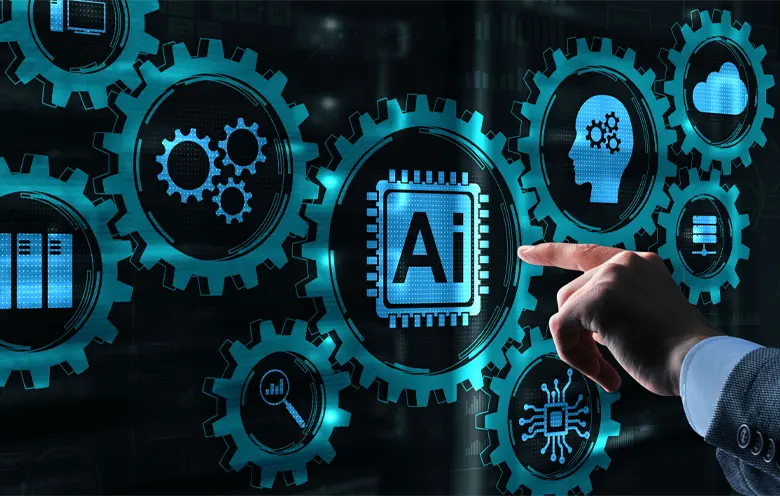In the early days, testing was solely manual, a tedious and error-prone process. The 1970s saw the introduction of record-and-playback tools, a rudimentary automation step. Testing frameworks followed in the 80s and 90s, providing structure and reusability. Today, AI and ML are revolutionizing the game with self-healing scripts, intelligent test generation, and continuous optimization. This is ushering in the future of efficient and impactful test automation services. If we talk about AI software testing, it goes beyond traditional automation by analyzing user behavior, predicting defects, and even adapting tests in real-time. This allows for a more comprehensive, efficient, and intelligent approach to software quality assurance.
Key advancements in AI-powered testing tools
The fusion of AI and ML has significantly changed test automation. These technologies empower AI testing tools to outperform traditional ones, enhancing efficiency and accuracy.
Let’s explore some major advancements that demonstrate the transformative impact of AI in test automation:
- Visual UI testing: Instead of merely pixel-by-pixel comparisons, AI algorithms now detect the smallest discrepancies and identify UI regressions with uncanny precision. This eliminates the time-consuming and error-prone process of manual visual checks, streamlining the identification and resolution of UI issues.
- Functional testing: By mimicking real user behavior, AI testing tools uncover hidden bugs that traditional scripts might overlook. This ensures comprehensive testing, revealing potential issues before they impact real users.
- Data-driven testing: Say goodbye to the tedious drudgery of manual data entry. AI dynamically generates test data based on real-world scenarios, mimicking actual user behavior and ensuring your tests are as relevant and impactful as possible. This eliminates the risk of testing with unrealistic data and provides a more accurate picture of your software’s performance in diverse scenarios.
- Performance testing: Predicting load patterns and identifying performance bottlenecks before they cripple your software is no longer a futuristic dream. AI in software testing optimizes performance by anticipating real-world usage and proactively addressing potential issues. This proactive approach ensures your software scales seamlessly and delivers a smooth user experience under pressure.
These are just a glimpse into the transformative potential of AI-powered testing tools. With continuous advancements and development, the future promises even more exciting innovations, further blurring the lines between human and machine intelligence in the realm of software testing.
Strategies for implementation: Embracing the AI revolution in test automation
The potential of AI-powered testing tools is undeniable. Successfully integrating them into your existing testing processes requires careful planning and strategic implementation. Here are some key strategies to ensure a smooth and effective transition:
- Start small and scale up: Don’t attempt to boil the AI ocean all at once. Begin with pilot projects in specific areas, focusing on high-impact processes where AI can significantly improve efficiency or coverage. This allows you to gain experience, build confidence, and identify potential challenges before a full-scale implementation.
- Focus on value, not hype: Remember, automation for automation’s sake is a recipe for wasted resources. Prioritize areas where AI can deliver tangible value, such as reducing testing time, improving quality, or uncovering hidden bugs. Align your AI testing initiatives with your overall testing objectives and business goals.
- Integrate seamlessly with existing tools: Leverage the power of AI without disrupting your existing workflow. Look for tools that seamlessly integrate with your existing testing frameworks and platforms, minimizing disruption and maximizing resource utilization. This ensures a smooth transition and promotes better adoption by your testing team.
- Invest in training and support: Embracing AI requires a shift in mindset and skillset. Equip your team with the knowledge and skills needed to work effectively with AI-powered testing tools. Provide thorough training programs and continuous support to ensure efficient utilization and maximize the benefits of AI integration.
- Monitor and iterate: Continuous monitoring and analysis are crucial for optimizing your AI testing efforts. Track key metrics like efficiency, accuracy, and bug detection rates. Regularly evaluate your AI tools and strategies, making adjustments and fine-tuning your approach based on the collected data. This iterative approach ensures you capitalize on the full potential of AI and achieve sustained improvements in your testing processes.
By implementing these strategies, you can navigate the AI revolution in QA automation testing services with confidence and unlock its transformative potential for your software development process. Remember, AI is not a replacement for human testers, but a powerful ally that can augment their capabilities and drive a new era of efficient and comprehensive software testing.
Challenges and solutions: Paving the path to AI-powered success
While the advancements in AI-powered testing tools are undoubtedly impressive, it’s crucial to acknowledge the challenges that may arise during implementation. Understanding and addressing these hurdles effectively will pave the way for a smooth and successful journey towards AI-driven test automation.
Let’s explore some key QA automation challenges and actionable solutions:
-
- Cost and complexity: AI tools can involve higher initial costs and require skilled personnel to operate. However, consider the long-term benefits: increased efficiency, improved quality, and reduced maintenance costs can significantly outweigh the initial investment. Additionally, explore open-source options and leverage training resources to mitigate the cost and skill gap.
- Explainability and trust: Understanding how AI algorithms make decisions is crucial for building trust in their recommendations. Look for tools that prioritize transparency and offer explainable AI features, allowing you to understand the reasoning behind identified issues and optimize your testing strategies accordingly.
- Data bias: AI algorithms are only as good as the data they’re trained on. Biased data can lead to inaccurate results and unfair testing practices. Implement strong data governance practices to ensure data quality and diversity, eliminate potential biases and foster fair and reliable testing outcomes.
- Lack of expertise: Navigating the complexities of AI-powered testing tools can be daunting for teams without adequate expertise. Invest in training programs and hire skilled professionals to bridge the knowledge gap and ensure effective utilization of AI tools. Remember, continuous learning and upskilling are crucial for successful AI integration.
- Integration challenges: Existing testing frameworks and platforms may not seamlessly integrate with AI tools. Prioritize solutions offering open APIs and strong compatibility with your existing infrastructure. This minimizes disruption and streamlines the integration process, fostering rapid adoption by your testing team.
By identifying and addressing these challenges, you can effectively utilize AI-powered tools to optimize your testing processes and drive significant improvements in efficiency, accuracy, and software quality. Remember, embracing AI is an ongoing journey, requiring continuous learning, adaptation, and refinement.
Embrace the future with Softweb Solutions: Your AI-powered test automation partner
AI and machine learning testing tools are driving the evolution of test automation to a pivotal point. While the opportunities are extensive, successfully navigating this frontier requires expertise, experience, and a strategic mindset. That’s where Softweb Solutions comes in.
We understand the challenges and opportunities of AI-powered test automation. And our dedication lies in helping you fully leverage its potential for your business.



